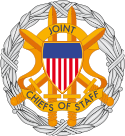
The United States Fleet Forces Command (USFF) is a service component command of the United States Navy that provides naval forces to a wide variety of U.S. forces. The naval resources may be allocated to Combatant Commanders such as United States Northern Command (USNORTHCOM) under the authority of the Secretary of Defense. Originally formed as United States Atlantic Fleet (USLANTFLT) in 1906, it has been an integral part of the defense of the United States of America since the early 20th century. In 2002, the Fleet comprised over 118,000 Navy and Marine Corps personnel serving on 186 ships and in 1,300 aircraft, with an area of responsibility ranging over most of the Atlantic Ocean from the North Pole to the South Pole, the Caribbean Sea, Gulf of Mexico, and the waters of the Pacific Ocean along the coasts of Central and South America.

John Smith Thach was a World War II Naval Aviator, air combat tactician, and United States Navy admiral. Thach developed the Thach Weave, a combat flight formation that could counter enemy fighters of superior performance, and later the big blue blanket, an aerial defense against kamikaze attacks.

The Seventh Fleet is a numbered fleet of the United States Navy. It is headquartered at U.S. Fleet Activities Yokosuka, in Yokosuka, Kanagawa Prefecture, Japan. It is part of the United States Pacific Fleet. At present, it is the largest of the forward-deployed U.S. fleets, with 60 to 70 ships, 300 aircraft and 40,000 Navy, Marine Corps personnel, and Coast Guard support personnel. Its principal responsibilities are to provide joint command in natural disaster or military operations and operational command of all US naval forces in the region.

The United States Third Fleet is one of the numbered fleets in the United States Navy. Third Fleet's area of responsibility includes approximately fifty million square miles of the eastern and northern Pacific Ocean areas including the Bering Sea, Alaska, the Aleutian Islands, and a sector of the Arctic. Major oil and trade sea lines of communication within this area are critically important to the economic health of the United States and friendly nations throughout the Pacific Rim region.

USS John S. McCain (DDG-56) is an Arleigh Burke-class destroyer currently in the service of the United States Navy. She is part of the Destroyer Squadron 15 within the Seventh Fleet, and has her homeport at the Yokosuka Naval Base in Yokosuka, Japan.
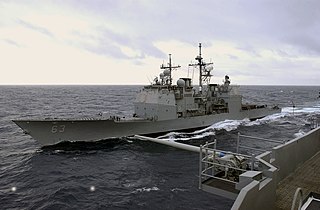
USS Cowpens (CG-63) is a Ticonderoga-class guided missile cruiser in service with the United States Navy. The ship is named after the Battle of Cowpens, a major American victory near Cowpens, South Carolina, in the American Revolution. She was built at the Bath Iron Works in Maine. Cowpens is stationed at Naval Base San Diego.

United States Fleet Activities Yokosuka or Commander Fleet Activities Yokosuka is a United States Navy base in Yokosuka, Japan. Its mission is to maintain and operate base facilities for the logistic, recreational, administrative support and service of the U.S. Naval Forces Japan, Seventh Fleet and other operating forces assigned in the Western Pacific. CFAY is the largest strategically important U.S. naval installation in the western Pacific.

John B. Nathman is a retired United States Navy admiral who served as the Commander, United States Fleet Forces Command until 17 May 2007.

Robert Frederick "Bob" Willard is a retired United States Navy admiral who last served as the 22nd Commander, U.S. Pacific Command from October 19, 2009 to March 9, 2012. He previously served as Commander, U.S. Pacific Fleet from May 8, 2007, to September 25, 2009. Prior to that, he served as the 34th Vice Chief of Naval Operations from March 18, 2005, to April 2007. On March 9, 2012, Admiral Willard retired from the Navy after 39 years of service. On May 9, 2012, he was elected president and chief executive officer of the Institute of Nuclear Power Operations, succeeding retired Navy admiral James O. Ellis, Jr.
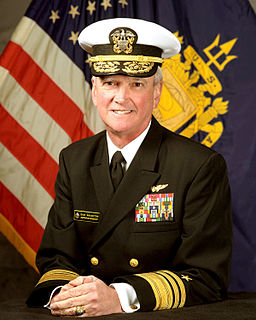
Rear Admiral Richard Joseph Naughton was the superintendent of the U.S. Naval Academy from 2002 to 2003.

Exercise Strikeback was a major naval exercise of the North Atlantic Treaty Organization (NATO) that took place over a ten-day period in September 1957.
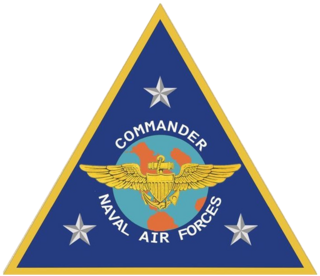
Commander, Naval Air Forces is the aviation Type Commander (TYCOM) for all United States Navy naval aviation units. Type Commanders are in Administrative Control (ADCON), and in some cases Operational Control (OPCON) of certain types of assets assigned to the Pacific and Atlantic Fleets. AIRFOR is responsible for the materiel readiness, administration, training, and inspection of units/squadrons under their command, and for providing operationally ready air squadrons and aircraft carriers to the fleet.

Carrier Strike Group 10, abbreviated as CSG-10 or CARSTRKGRU 10, is a U.S. Navy carrier strike group. Carrier strike groups gain and maintain sea control as well as project naval airpower ashore.

Carrier Strike Group 15, is a training formation of the United States Navy. It trains and certifies Pacific Fleet Carrier Strike Groups, Amphibious Ready Groups, and independently deploying surface ships. It replaced Commander, Strike Force Training Pacific in a title change. Carrier Strike Group Four is the equivalent command for US Fleet Forces ships.

Walter Edward "Ted" Carter Jr. is president of the University of Nebraska System. Carter was confirmed by the university's board of regents as the eighth permanent president of the university on Dec. 5, 2019. Carter is a retired United States Navy vice admiral and Naval Flight Officer. He was the 62nd superintendent of the United States Naval Academy and 54th president of the U.S. Naval War College.

Commander, Carrier Strike Group 8, abbreviated as CCSG-8 or COMCARSTRKGRU 8, is one of five U.S. Navy carrier strike groups currently assigned to the United States Fleet Forces Command. Carrier strike groups gain and maintain sea control as well as project naval airpower ashore.
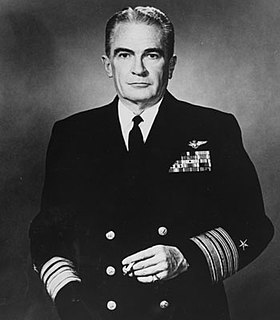
Herbert Douglas Riley was a highly decorated officer in the United States Navy with the rank of Vice admiral. A Naval Academy graduate, he trained as naval aviator and distinguished himself first as Commanding officer of escort aircraft carrier USS Makassar Strait during the combats at Iwo Jima and Okinawa during World War II.

Early on 17 June 2017, the United States Navy destroyer USS Fitzgerald collided with MV ACX Crystal, a Philippine-flagged container ship, about 80 nautical miles southwest of Tokyo, Japan; 10 nautical miles southeast of the city of Shimoda on the Japanese mainland (Honshu).

At 5:24 a.m. on 21 August 2017 USS John S. McCain, a United States Navy warship, was involved in a collision with the Liberian-flagged tanker Alnic MC off the coast of Singapore and Malaysia, east of the Strait of Malacca. According to a U.S. Navy press release, the breach "resulted in flooding to nearby compartments, including crew berthing, machinery, and communications rooms." Ten US Navy sailors died as a result of the crash, which prompted the Maritime and Port Authority (MPA) of Singapore to start a multi-agency search-and-rescue (SAR) effort as the agency responsible for coordinating SAR operations within Singapore's Maritime Search and Rescue Region (MSRR). The Singapore Transport Safety Bureau (TSIB) also launched a marine safety investigation following the collision in accordance with the International Maritime Organisation's Casualty Investigation Code in Singapore's capacity as a coastal state, and published its final report on 8 March 2018. The U.S. Navy announced on 24 August 2017 that it had suspended search-and-rescue efforts for survivors in the open sea to focus on the recovery of the remains of the missing sailors still inside the flooded compartments of the ship. By 27 August U.S. Navy and United States Marine Corps divers had recovered the remains of all ten sailors. On 12 September 2017, the United States' chargé d'affaires Stephanie Syptak-Ramnath expressed thanks for Singapore's support during the SAR operations. The McCain returned to service in June of 2020.

John Christopher Aquilino is an admiral in the United States Navy, serving as the commander of the United States Indo-Pacific Command since April 30, 2021. He previously served as the commander of the United States Pacific Fleet and before that, commander of the United States Fifth Fleet and Combined Maritime Forces.

